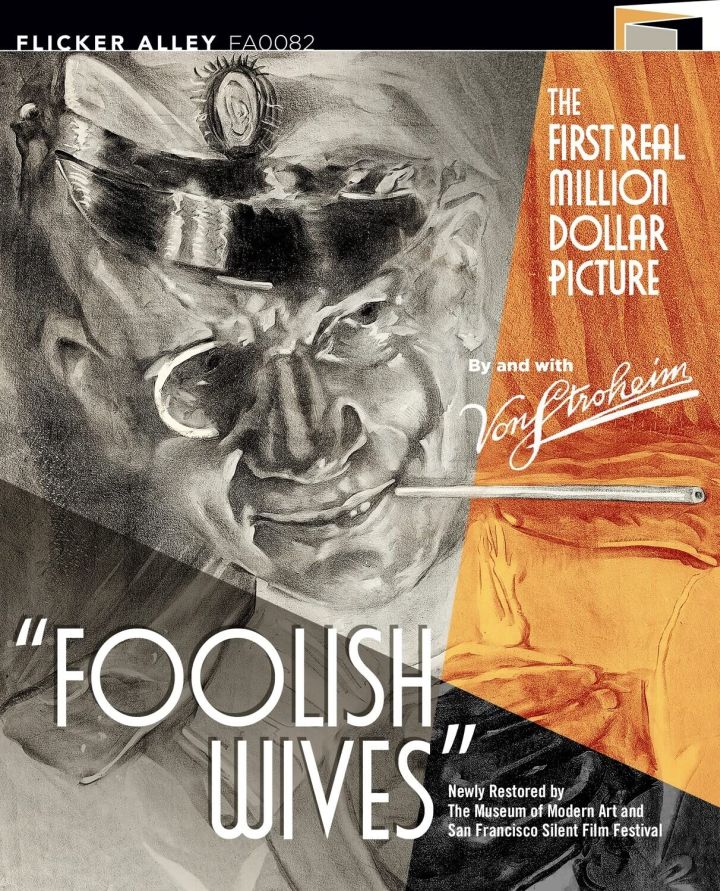
Erich von Stroheim, the director of Foolish Wives, was well known for his aristocratic and military background. He was a perfect Austrian martinet. His on-screen persona usually mirrored this background. He would play soldiers and aristocrats, often as the heavy. First coming to prominence in the mid-1910s, at the height of World War I, he was perfectly positioned to portray evil and authentic Germans in propaganda films.
The problem with this authenticity is that it was all based on a lie. Stroheim was actually the son of a middle-class Jewish hat maker. He was never really in the military. His entire history is a self-invention, and though some people who knew him may have suspected, no one actually knew in his lifetime, including his wives, that his background was complete fiction. It’s fitting then that Foolish Wives (1922), the third film he directed and starred in, Erich von Stroheim plays a poseur. He pretends to be Count Sergius, a Russian in exile just waiting for his money to finally arrive from the Mother country. With this front, he seduces women and then blackmails them.
Living in a hotel in Monte Carlo with his two “cousins”, the trio have no money of their own. But they are involved with a talented counterfeiter, whose money they slip into the local casinos. How this ends up profiting them isn’t clear, but there is much that is not clear in Foolish Wives. When Sergius reads in the paper that a rich American envoy, Henry Hughes, will be coming to Monte Carlo with a bride, Helen, nearly 20 years his junior, the Count picks her out as his next target.
He tricks her with his charms, and through various bold schemes manages to be alone with her, repeatedly. First, it’s a peddle boat ride, then a trip to the country where a storm forces them to be out together all night.
The Count’s main conflict is that though he wants the money, he also wants to prove his great seductive powers. It’s not enough for him to implicate Helen, he must really get her. I think. Foolish Wives‘ story never makes a lot of sense. Several connections are left for the audience to infer, or just completely guess about.
What it does have is a sense of grandeur. It was advertised as “The First Real Million Dollar Picture” and the production is about as lavish as it could possibly be in the early ’20s. Stroheim lavishly recreated Monte Carlo on the California coast. The structures are enormous and look like the real thing. There are several shots with dozens of extras, maybe more, all in continental costume.
All of this came at enormous cost and the 11-month production was apparently a nightmare. Stroheim delivered a monster of a film, over six hours long. Eventually, cut down to just over three hours, the premiere was a disaster as the movie was an incomprehensible mess. What survives now has enough story to be a film.
But perhaps not a particularly scintillating film. Foolish Wives has more of an implication of a story than a well-thought-out narrative, and there are several scenes still that just go on and on without making much of a point or an impression.
Besides the spectacle, the main attraction of the film is Stroheim’s performance. He’s in most scenes in the existing film, and he exudes cinematic charisma. He absolutely loves playing a heel who lives to trick women. There are even a few times where, in the middle of some particularly bold bit of skullduggery, he’ll smile and almost look at the camera. What a bad boy he is.
The film has been recently restored by the San Francisco Silent Film Festival and MOMA. This Blu-ray and DVD release is by Flicker Alley, who specialize in preserving film history. And the disc is excellent in their typical fashion. With a film over 100 years old, one cannot expect the materials to be perfectly preserved and within scenes there will be some shots suddenly out of focus or obviously damaged. That’s to be expected, but what’s presented here often looks remarkably good. It also includes an orchestral score by Timothy Brock which I found to be excellent.
It’s a very high-quality release of a historically significant film, which is unfortunately dramatically unsatisfying. There are two absolutely bravura sequences, one with a raging storm, another with a house fire that are masterful. They mix suspense with action and show that, for all his pretense and pretend, Stroheim could forge forceful images and involving dramatic scenarios. There’s just too little of that, and too many very long scenes of not much happening, very prettily. This is not a film to introduce silent film to your friends. But for those interested in the film’s history and production, this release of Foolish Wives will give them all they could ask for.
Foolish Wives has been released by Flicker Alley on Blu-ray and DVD in one package. The release includes copious extras. Video extras include “Filming ‘Foolish Wives‘” (2 min), an excerpt from an old Pathe newsreel that shows some behind the scenes footage; “The Waves and the Merry-Go-Round: On Location with Erich von Stroheim” (38 min), a documentary about the film’s locations by historian Bran Rosenstein; “Erich von Stroheim and Hollywood’s First Million-dollar Picture” (15 min), a presentation by MoMA film curator Dave Kehr on Stroheim’s life and the making of the film; “Restoring Foolish Wives” (14 min), a look at the restoration of the film; “Source Comparison Demo” (4 min), which presents a comparison of the various sources used to restore the film; “Restoration Demo” (3 min), a before and after clip demonstrating the restoration of the film. There’s are also photo galleries and a booklet with an essay on the film by James Layton, excerpts from critic David Thomson, and an introduction to the score by the composer Timothy Brock.